Baby rashes: a visual guide
From nappy rash and eczema to impetigo and slapped cheek syndrome, use this visual guide to help you recognise different baby rashes.
Visit the visual guide to baby rashes on NHS Choices.Baby acne

Acne is most common in teenagers and young adults, but newborn babies can also be affected in the first few weeks of life. Acne develops when hair follicles in the skin get blocked with excess sebum (the oil produced by the skin) and dead skin cells.
It is not known why acne appears in babies. It may be caused by hormones received by the baby from the mother. It could also be a reaction to an oily skincare product. If the acne does not clear up after three months, see your GP for further advice.
Read more about skin rashes in babiesEczema

The commonest form of eczema is known as atopic eczema and it mainly affects children. Eczema causes the skin to become itchy, dry, red and cracked.
It commonly affects areas where the skin folds, such as behind the knees, the crease of the elbows, the neck and around the eyes and ears.
Eczema is a long-term condition, but it clears up by the age of 11 in over half of cases. Your GP can advise you on treatment, such as creams to soothe the itching.
Read more about atopic eczemaErythema multiforme
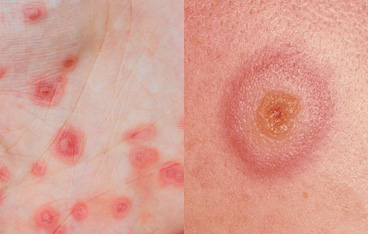
Erythema multiforme is a skin reaction triggered by medication, an infection (usually the herpes simplex virus) or an illness.
Red spots develop on the hands or feet before spreading across the body. Your baby will probably feel unwell and may have a fever, but you should be able to treat these symptoms with over-the-counter medicine. It may take two to six weeks before your baby feels better.
Read more about skin rashes in babiesHand, foot and mouth
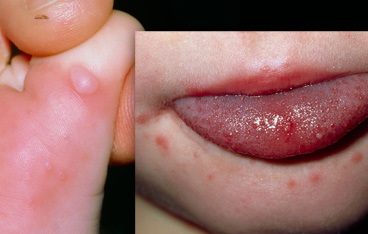
Hand, foot and mouth disease gets its name from the rash that can appear on the hands and feet or ulcers that can appear in the mouth.
It is common in children under 10 and is also very contagious. Adults are usually immune to the virus. The rash on the skin is not itchy and the spots are flat or raised (sometimes with blisters) but are smaller in size than chickenpox sores. Hand, foot and mouth disease will clear up on its own. However, it can make babies feel generally unwell with symptoms including loss of appetite, fever and sore throat.
Read more about hand, foot and mouthHives
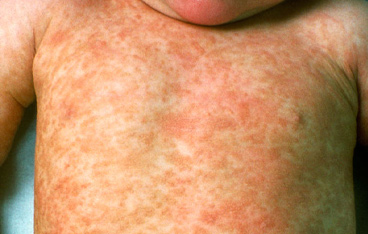
Hives or urticaria (also known as nettle rash or welts) is a raised, red, itchy rash that appears on the skin. Urticaria happens when a trigger causes an allergic reaction. The trigger could be a certain food or a sting from a nettle, bee or wasp.
It causes the body to release a protein called histamine. Histamine causes tiny blood vessels, called capillaries, to leak fluid. The fluid collects in the skin and causes a rash. The rash normally disappears after a few days, but some cases can last longer. It isn't contagious.
Read more about hivesImpetigo
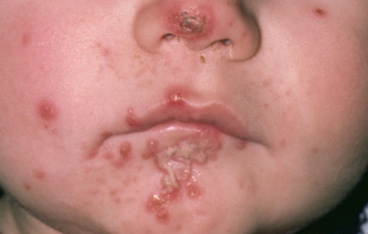
Impetigo is a skin infection caused by bacteria. It begins with a rash and blisters that burst, leaving thick, yellow-brown golden crusts. The sores tend to develop around the nose and mouth and are not painful but may be itchy. Impetigo is common in children but can occur at any age.
It will clear up without treatment in 2 to 3 weeks, but treatment is advised as impetigo is contagious. With treatment, impetigo will clear up in 7 to 10 days. An antibiotic cream is the usual treatment. Oral antibiotics may also be required if the rash is widespread. Other symptoms, such as fever and swollen glands, are rare but may occur in more severe cases.
Read more about impetigoKeratosis pilaris
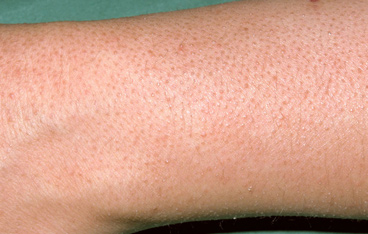
Keratosis pilaris is a harmless, non-contagious and common condition in which areas of the skin appear to be permanently covered in goose pimples. It is often caused when pores become blocked with excess keratin, a protein found in the outer layers of the skin.
Skin affected by the condition can be rough, bumpy and almost like sandpaper in texture. It is most often seen on the back of the upper arms, the thighs and buttocks. The affected skin may be itchy in some people. Moisturisers may help the skin by reducing dryness and gentle exfoliation may also help.
Read more about keratosis pilarisMeningitis

Meningitis is an infection caused by bacteria or a virus. It affects the protective membranes that surround the brain and spinal cord (the meninges). The distinctive skin rash associated with meningitis may not appear in every case. However, itís important to recognise this and other symptoms of meningitis, and to know how to perform the tumbler test.
If a child is clearly ill and a purplish or red rash has appeared, push the side of a glass or tumbler against the skin. If the rash does not disappear and you can still see the rash through the tumbler, they may have septicaemia (blood poisoning), which can be fatal. Because of this, meningitis should be treated as a medical emergency.
Read more about meningitisMilia
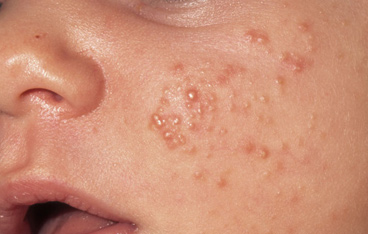
Milia are pearly white cysts that appear just under the skin's surface, usually on the cheeks and eyelids. They are caused by the pores becoming blocked with keratin, a protein produced by the skin.
Milia are common in babies and affect around half of all newborns. Milia do not need to be treated and often disappear within a few weeks of birth.
Read more about skin rashes in babiesNappy rash
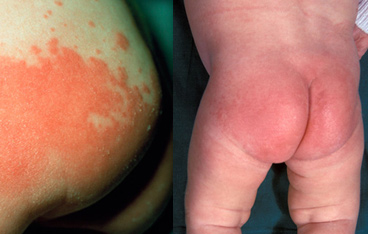
Nappy rash is a common condition caused when a baby's skin comes into contact with urine and faeces. It is thought to affect up to a third of nappy-wearing babies and causes skin to become sore, irritated and sometimes red and blotchy.
If it is mild, nappy rash will not require medication or special treatment. However, if bright-red spots appear or the skin becomes swollen and blistered or dry and cracked, see your GP. These symptoms suggest a fungal infection.
Read more about nappy rashPrickly heat

Prickly heat causes a rash made up of tiny spots or bumps, surrounded by a patch of red skin. Sometimes, the spots look like tiny blisters.
This rash may cause mild swelling, itching, stinging or a prickling sensation and tends to appear on a baby's trunk or hands and feet. Prickly heat is a common condition in babies and is thought to be caused by underdeveloped sweat glands. If you are concerned, your GP can give you advice.
Read more about prickly heatRingworm
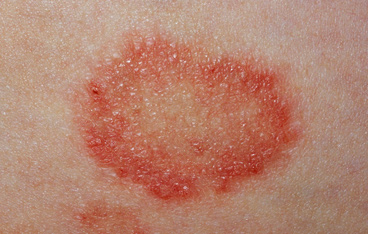
Ringworm is an infection caused by a fungus (not a worm as the name suggests). It is called ringworm because it causes ring-like, red lesions on the skin.
The skin appears red and inflamed around the ring yet healthy inside it. The rings will feel slightly raised to the touch and may feel itchy. Ringworm is not a serious condition. Most cases are mild can be treated with antifungal cream.
Read more about ringwormSlapped cheek syndrome
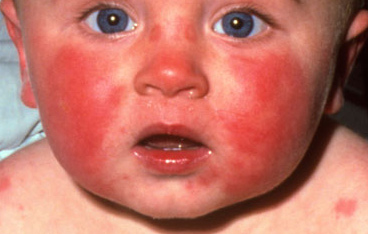
Slapped cheek syndrome is a viral infection and is common in babies. After an initial phase of flu-like symptoms (fever, sore throat, headache, upset stomach), a distinctive blotchy red rash may appear on the face.
This gives the appearance of slapped cheeks. The rash may become itchy and spread to the body and limbs. Most babies will not need treatment and it will clear up in a few days.
Read more about Slapped cheek syndromeVisit the visual guide to baby rashes on NHS Choices.
NHS Choices 2012